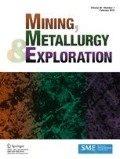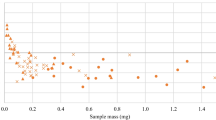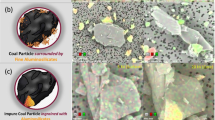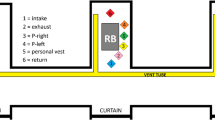Abstract
This paper presents a case study of respirable dust characterization in a thin-seam coal mine in southern WV. Samples were collected in the intake, near the feeder breaker, and downwind of an active roof bolter, as well as in three downwind locations from the continuous miner during four separate cuts. The dust was analyzed using: scanning electron microscopy with energy-dispersive X-ray (SEM–EDX) to estimate particle size and mineralogy distributions; thermogravimetric analysis (TGA) to estimate coal, non-carbonate, and carbonate mass fractions; and Fourier transform-infrared (FT-IR) spectroscopy to estimate quartz and kaolinite mass content. SEM–EDX results were generally consistent with those obtained in previous studies of other central Appalachian mines, including presence of relatively high non-carbonate minerals content (primarily aluminosilicates and silica) associated with the rock strata encountered in the mine. Downwind of the miner, fine aluminosilicate particles were particularly abundant and apparently influenced the SEM–EDX analysis for some samples, resulting in underestimation of coal content relative to TGA. Comparison of the microscopy results to those from the TGA and FT-IR indicates some interference between aluminosilicates and coal dust is simply due to high sample loading—however, presence of coal-mineral micro-agglomerates is also indicated.





Similar content being viewed by others
References
Doney BC, Blackley D, Hale JM, Halldin C, Kurth L, Syamlal G, Laney AS (2019) Respirable coal mine dust in underground mines. Am J Ind Med 62(6):478–485
Blackley DJ, Crum JB, Halldin CN, Storey E, Laney AS (2016) Resurgence of Progressive Massive Fibrosis in Coal Miners — Eastern Kentucky. Morb Mortal Wkly Rep 65(49):1385–1389
Blackley D, Reynolds L, Short C, Carson R, Storey E, Halldin C, Laney A (2018) Progressive massive fibrosis in coal miners from 3 clinics in Virginia. JAMA 319(5):500–501
Cohen RA, Petsonk EL, Rose C, Young B, Regier M, Najmuddin A, Abraham JL, Churg A, Green FHY (2016) Lung pathology in U.S. coal workers with rapidly progressive pneumoconiosis implicates silica and silicates. Am J Respir Crit Care Med 193(6):673–680
Jelic TM, Estalilla OC, Sawyer-Kaplan PR, Plata MJ, Powers JT, Emmett M, Kuenstner JT (2017) Coal mine dust desquamative chronic interstitial pneumonia: A precursor of dust-related diffuse fibrosis and of emphysema. Int J Occup Environ Med 8(3):153–165
National Academies of Sciences E, Medicine. 2018. Monitoring and sampling approaches to assess underground coal mine dust exposures. The National Academies Press, Washington, DC
Laney A, Weissman D (2014) Respiratory diseases caused by coal mine dust. J Occup Environ Med 56(010):S18–S22
Sapko M, Cashdollar K, Green G (2007) Coal dust particle size survey of US mines. J Loss Prev Process Ind 20(4–6):616–620
Sellaro R, Sarver E (2014) Characterization of respirable dust in an underground coal mine in Central Appalachia. Trans SME 336:457–546
Johann-Essex V, Keles C, Rezaee M, Scaggs-Witte M, Sarver E (2017) Respirable coal mine dust characteristics in samples collected in central and northern Appalachia. Int J Coal Geol 182(September):85–93
Sarver E, Keles C, Rezaee M (2019) Beyond conventional metrics: Comprehensive characterization of respirable. Int J Coal Geol 207:84–95
Sarver E, Keleş C, Afrouz S (2021) Particle size and mineralogy distributions in respirable dust samples from 25 US underground coal mines. Int J Coal Geol 247:103851. https://doi.org/10.1016/j.coal.2021.103851
Cauda E, Miller A, Drake P (2016) Promoting early exposure monitoring for respirable crystalline silica: Taking the laboratory to the mine site. J Occup Environ Hyg 13(3):D39–D45
Agioutanti E, Keles C, Sarver E (2020) thermogravimetric analysis application to determine coal, carbonate, and non-carbonate minerals mass fractions in respirable mine dust. J Occup Environ Hyg 17(2–3):1–12
Gonzalez J, Pokhrel N, Jaramillo L, Keles C, Sarver E (2021) Respirable dust characterization using SEMEDX and FT-IR: A case study in an Appalachian coal mine. In Proceedings of the 18th North American Mine Ventilation Symposium. Rapid City, SD, pp 189–197. https://doi.org/10.1201/9781003188476
Johann-Essex V, Keles C, Sarver E (2017) A computer-controlled SEM-EDX routine for characterizing respirable coal mine dust. Minerals 7(1):14–16
Miller AL, Drake PL, Murphy NC, Cauda EG, LeBouf RF, Markevicius G (2013) Deposition uniformity of coal dust on filters and its effect on the accuracy of FT-IR analyses for silica. Aerosol Sci Technol 47(7):724–733
Pokhrel N, Agioutanti E, Keleş Ç, Afrouz SG, Sarver E (2022) Comparison of Respirable Coal Mine Dust Constituents Estimated using FTIR, TGA, and SEM–EDX. Mining Metall Explor 39(2):291–300
Gonzalez J, Keleş Ç, Pokhrel N, Jaramillo L, Sarver E (2022) On the Occurrence and Persistence of Coal-Mineral Microagglomerates in Respirable Coal Mine Dust. Mining Metall Explor 39(2):271–282
Acknowledgements
The authors thank The National Institute for Occupational Safety and Health for funding this work. We also gratefully acknowledge the mine personnel that provided access to their operation and logistical assistance during the sampling campaign. The views and opinions expressed herein are solely those of the authors and do not imply any endorsement by research partners or funding source.
Author information
Authors and Affiliations
Corresponding author
Ethics declarations
Conflicts of Interest
The authors declare no conflict of interest. The funders had no role in the design of the study; in the collection, analyses, or interpretation of data; in the writing of the manuscript, or in the decision to publish the results.
Additional information
Publisher's Note
Springer Nature remains neutral with regard to jurisdictional claims in published maps and institutional affiliations.
Rights and permissions
About this article
Cite this article
Gonzalez, J., Keles, C., Pokhrel, N. et al. Respirable dust constituents and particle size: a case study in a thin-seam coal mine. Mining, Metallurgy & Exploration 39, 1007–1015 (2022). https://doi.org/10.1007/s42461-022-00611-2
Received:
Accepted:
Published:
Issue Date:
DOI: https://doi.org/10.1007/s42461-022-00611-2




